Research on Glacier Changes and Their Influencing Factors in the Yigong Zangbo River Basin of the Tibetan Plateau, China, Based on ICESat-2 Data
Abstract
:1. Introduction
2. Study Area and Datasets
2.1. Study Area
2.2. Dataset
2.2.1. ICESat-2 Data
2.2.2. ALOS DEM Data
2.2.3. Meteorological Data
2.2.4. Auxiliary Data
3. Methods
3.1. Estimates of Glacier Mass Change
3.2. Decomposition of Seasonal Trends
3.3. Analysis of Influencing Factors
3.3.1. XGBoost Model
3.3.2. SHAP Model
4. Results
4.1. Interannual and Seasonal Variations of Glaciers
4.2. Spatial Distribution of Glacier Change
4.3. Analysis of Influencing Factors of Glacier Changes
4.4. Characteristics of Climate Change in the Study Area
4.5. Uncertainties of Glacier Mass Change
5. Discussion
5.1. Spatio-Temporal Characteristics of Glacier Changes
5.2. Meteorological Drivers of Glacier Changes
6. Conclusions
Author Contributions
Funding
Data Availability Statement
Acknowledgments
Conflicts of Interest
References
- Immerzeel, W.W.; Lutz, A.F.; Andrade, M.; Bahl, A.; Biemans, H.; Bolch, T.; Hyde, S.; Brumby, S.; Davies, B.; Elmore, A. Importance and vulnerability of the world’s water towers. Nature 2020, 577, 364–369. [Google Scholar] [CrossRef] [PubMed]
- Yao, T.; Bolch, T.; Chen, D.; Gao, J.; Immerzeel, W.; Piao, S.; Su, F.; Thompson, L.; Wada, Y.; Wang, L. The imbalance of the Asian water tower. Nat. Rev. Earth Environ. 2022, 3, 618–632. [Google Scholar] [CrossRef]
- Zhang, G.; Bolch, T.; Chen, W.; Crétaux, J.-F. Comprehensive estimation of lake volume changes on the Tibetan Plateau during 1976–2019 and basin-wide glacier contribution. Sci. Total Environ. 2021, 772, 145463. [Google Scholar] [CrossRef]
- Pritchard, H.D. Asia’s shrinking glaciers protect large populations from drought stress. Nature 2019, 569, 649–654. [Google Scholar] [CrossRef]
- Yang, W.; Yao, T.; Guo, X.; Zhu, M.; Li, S.; Kattel, D.B. Mass balance of a maritime glacier on the southeast Tibetan Plateau and its climatic sensitivity. J. Geophys. Res. Atmos. 2013, 118, 9579–9594. [Google Scholar] [CrossRef]
- Gardelle, J.; Berthier, E.; Arnaud, Y.; Kääb, A. Region-wide glacier mass balances over the Pamir-Karakoram-Himalaya during 1999–2011. Cryosphere 2013, 7, 1263–1286. [Google Scholar] [CrossRef]
- Jouberton, A.; Shaw, T.E.; Miles, E.; McCarthy, M.; Fugger, S.; Ren, S.; Dehecq, A.; Yang, W.; Pellicciotti, F. Warming-induced monsoon precipitation phase change intensifies glacier mass loss in the southeastern Tibetan Plateau. Proc. Natl. Acad. Sci. USA 2022, 119, e2109796119. [Google Scholar] [CrossRef]
- Gharehchahi, S.; Ballinger, T.J.; Jensen, J.L.; Bhardwaj, A.; Sam, L.; Weaver, R.C.; Butler, D.R. Local-and regional-scale forcing of glacier mass balance changes in the swiss alps. Remote Sens. 2021, 13, 1949. [Google Scholar] [CrossRef]
- Veettil, B.K.; Kamp, U. Glacial lakes in the andes under a changing climate: A review. J. Earth Sci. 2021, 32, 1575–1593. [Google Scholar] [CrossRef]
- Luo, L.-H.; Ke, C.-Q.; Fan, Y.-B.; Wang, Z.-F. Accelerated glacier mass loss in the southeastern Tibetan Plateau since the 1970s. Adv. Clim. Chang. Res. 2023, 14, 372–386. [Google Scholar] [CrossRef]
- Li, G.; Lin, H. Recent decadal glacier mass balances over the Western Nyainqentanglha Mountains and the increase in their melting contribution to Nam Co Lake measured by differential bistatic SAR interferometry. Glob. Planet. Chang. 2017, 149, 177–190. [Google Scholar] [CrossRef]
- Yao, T.; Pu, J.; Lu, A.; Wang, Y.; Yu, W. Recent glacial retreat and its impact on hydrological processes on the Tibetan Plateau, China, and surrounding regions. Arct. Antarct. Alp. Res. 2007, 39, 642–650. [Google Scholar] [CrossRef]
- Ke, C.-Q.; Lee, H.; Han, Y.-F. Glacier Change in the Yigong Zangbo Basin, Tibetan Plateau, China. Korean J. Remote Sens. 2019, 35, 491–502. [Google Scholar]
- Wang, Q.; Duan, H.; Liu, N.; Du, Z.; Wang, P.; Yi, B.; Xu, J.; Huang, J.; Zhang, Y.; Yao, X. Change of moraine-dammed glacial lakes and simulation of glacial lake outburst flood in the Yi’ong Zangbo River basin. Front. Earth Sci. 2022, 10, 881285. [Google Scholar] [CrossRef]
- Romshoo, S.A.; Murtaza, K.O.; Abdullah, T. Towards understanding various influences on mass balance of the Hoksar Glacier in the Upper Indus Basin using observations. Sci. Rep. 2022, 12, 15669. [Google Scholar] [CrossRef]
- Zhou, Y.; Li, Z.; Li, J.; Zhao, R.; Ding, X. Geodetic glacier mass balance (1975–1999) in the central Pamir using the SRTM DEM and KH-9 imagery. J. Glaciol. 2019, 65, 309–320. [Google Scholar] [CrossRef]
- Ye, Q.; Zong, J.; Tian, L.; Cogley, J.G.; Song, C.; Guo, W. Glacier changes on the Tibetan Plateau derived from Landsat imagery: Mid-1970s–2000–13. J. Glaciol. 2017, 63, 273–287. [Google Scholar] [CrossRef]
- Li, H.; Wang, P.; Li, Z.; Wang, P.; Xu, C.; Liu, S.; Jin, S.; Zhang, Z.; Xu, L. Research on the changes of the Urumqi Glacier No. 1, Tianshan Mountains based on multi-source remote sensing data. J. Glaciol. Geocryol. 2021, 43, 1018–1026. [Google Scholar]
- Cheng, C.; Du, W.; Li, J.; Bao, A.; Ge, W.; Wang, S.; Ma, D.; Pan, Y. Spatiotemporal Variations of Glacier Mass Balance in the Tomur Peak Region Based on Multi-Source Altimetry Remote Sensing Data. Remote Sens. 2023, 15, 4143. [Google Scholar] [CrossRef]
- Lin, H.; Li, G.; Cuo, L.; Hooper, A.; Ye, Q. A decreasing glacier mass balance gradient from the edge of the Upper Tarim Basin to the Karakoram during 2000–2014. Sci. Rep. 2017, 7, 6712. [Google Scholar] [CrossRef]
- Li, G.; Li, Y.; Lin, H.; Ye, Q.; Jiang, L. Two periods of geodetic glacier mass balance at Eastern Nyainqentanglha derived from multi-platform bistatic SAR interferometry. Int. J. Appl. Earth Obs. Geoinf. 2021, 104, 102541. [Google Scholar] [CrossRef]
- Ye, Q.; Zhang, X.; Wang, Y.; Zhang, Z.; Hu, Y.; Zhu, L. Monitoring glacier thinning rate in Rongbuk Catchment on the northern slope of Mt. Qomolangma from 1974 to 2021. Ecol. Indic. 2022, 144, 109418. [Google Scholar] [CrossRef]
- Chen, W.; Yao, T.; Zhang, G.; Li, F.; Zheng, G.; Zhou, Y.; Xu, F. Towards ice-thickness inversion: An evaluation of global digital elevation models (DEMs) in the glacierized Tibetan Plateau. Cryosphere 2022, 16, 197–218. [Google Scholar] [CrossRef]
- Yue, L.; Shen, H.; Yu, W.; Zhang, L. Monitoring of historical glacier recession in yulong mountain by the integration of multisource remote sensing data. IEEE J. Sel. Top. Appl. Earth Obs. Remote Sens. 2018, 11, 388–400. [Google Scholar] [CrossRef]
- Laskar, A.H.; Bhattacharya, S.K.; Rao, D.K.; Jani, R.A.; Gandhi, N. Seasonal variation in stable isotope compositions of waters from a Himalayan river: Estimation of glacier melt contribution. Hydrol. Process. 2018, 32, 3866–3880. [Google Scholar] [CrossRef]
- Wang, K.; Kong, Y.; Pu, T.; Shi, X.; Pang, Z. Seasonal variations of a glacier river runoff components as relative to changes of air temperature and precipitation in southeast Tibetan Plateau. Appl. Geochem. 2024, 162, 105909. [Google Scholar] [CrossRef]
- Xue, Y.; Hong, X.; He, X.; Kang, S.; Wang, S.; Ding, Y. An evaluation of TLS-based glacier change assessment in the central Tibetan plateau. Int. J. Digit. Earth 2024, 17, 2375527. [Google Scholar] [CrossRef]
- Xu, X.; Wang, W.; Huang, D.; Hu, X.; Fu, W. Assessment of interannual and seasonal glacier mass changes in the Karakoram during 2018–2022 using ICESat-2 data. J. Hydrol. 2023, 626, 130223. [Google Scholar] [CrossRef]
- Shen, C.; Jia, L.; Ren, S. Inter-and intra-annual glacier elevation change in high mountain Asia region based on ICESat-1&2 data using elevation-aspect bin analysis method. Remote Sens. 2022, 14, 1630. [Google Scholar] [CrossRef]
- Su, B.; Xiao, C.; Chen, D.; Huang, Y.; Che, Y.; Zhao, H.; Zou, M.; Guo, R.; Wang, X.; Li, X. Glacier change in China over past decades: Spatiotemporal patterns and influencing factors. Earth-Sci. Rev. 2022, 226, 103926. [Google Scholar] [CrossRef]
- Wang, R.; Liu, S.; Shangguan, D.; Radić, V.; Zhang, Y. Spatial heterogeneity in glacier mass-balance sensitivity across High Mountain Asia. Water 2019, 11, 776. [Google Scholar] [CrossRef]
- Niu, S.; Sun, M.; Wang, G.; Wang, W.; Yao, X.; Zhang, C. Glacier Change and Its Influencing Factors in the Northern Part of the Kunlun Mountains. Remote Sens. 2023, 15, 3986. [Google Scholar] [CrossRef]
- Yao, T.; Thompson, L.; Yang, W.; Yu, W.; Gao, Y.; Guo, X.; Yang, X.; Duan, K.; Zhao, H.; Xu, B. Different glacier status with atmospheric circulations in Tibetan Plateau and surroundings. Nat. Clim. Chang. 2012, 2, 663–667. [Google Scholar] [CrossRef]
- Lundberg, S.M.; Lee, S.-I. A unified approach to interpreting model predictions. Adv. Neural Inf. Process. Syst. 2017, 30, 4765–4774. [Google Scholar]
- Li, Z. Extracting spatial effects from machine learning model using local interpretation method: An example of SHAP and XGBoost. Comput. Environ. Urban Syst. 2022, 96, 101845. [Google Scholar] [CrossRef]
- Zhang, X.; Gou, P.; Chen, W.; Li, G.; Huang, Y.; Zhou, T.; Liu, Y.; Nie, W. Spatiotemporal distribution characteristics of ecosystem health and the synergetic impact of its driving factors in the Yangtze River Delta, China. Environ. Sci. Pollut. Res. 2023, 30, 85184–85197. [Google Scholar] [CrossRef]
- Utkin, L.; Konstantinov, A. Ensembles of random SHAPs. Algorithms 2022, 15, 431. [Google Scholar] [CrossRef]
- Shi, Y.; Liu, S. Estimation on the response of glaciers in China to the global warming in the 21st century. Chin. Sci. Bull. 2000, 45, 668–672. [Google Scholar] [CrossRef]
- Markus, T.; Neumann, T.; Martino, A.; Abdalati, W.; Brunt, K.; Csatho, B.; Farrell, S.; Fricker, H.; Gardner, A.; Harding, D. The Ice, Cloud, and land Elevation Satellite-2 (ICESat-2): Science requirements, concept, and implementation. Remote Sens. Environ. 2017, 190, 260–273. [Google Scholar] [CrossRef]
- Du, W.; Liu, X.; Guo, J.; Shen, Y.; Wang, L.; Chang, X. Analysis of the melting glaciers in Southeast Tibet by ALOS-PALSAR data. TAO Terr. Atmos. Ocean. Sci. 2019, 30, 7. [Google Scholar] [CrossRef]
- Yang, K.; Jiang, Y.; Tang, W.; He, J.; Shao, C.; Zhou, X.; Lu, H.; Chen, Y.; Li, X.; Shi, J. A High-Resolution Near-Surface Meteorological Forcing Dataset for the Third Pole Region (TPMFD, 1979–2022); National Tibetan Plateau/Third Pole Environment Data Center: Beijing, China, 2023. [Google Scholar]
- Arendt, A.; Bliss, A.; Bolch, T.; Cogley, J.; Gardner, A.; Hagen, J.-O.; Hock, R.; Huss, M.; Kaser, G.; Kienholz, C. Randolph Glacier Inventory–A Dataset of Global Glacier Outlines: Version 6.0: Technical Report, Global Land Ice Measurements from Space. 2017. Available online: http://www.glims.org/RGI/randolph60.html (accessed on 2 June 2024).
- Nuth, C.; Kääb, A. Co-registration and bias corrections of satellite elevation data sets for quantifying glacier thickness change. Cryosphere 2011, 5, 271–290. [Google Scholar] [CrossRef]
- Farinotti, D.; Longuevergne, L.; Moholdt, G.; Duethmann, D.; Mölg, T.; Bolch, T.; Vorogushyn, S.; Güntner, A. Substantial glacier mass loss in the Tien Shan over the past 50 years. Nat. Geosci. 2015, 8, 716–722. [Google Scholar] [CrossRef]
- Huss, M. Density assumptions for converting geodetic glacier volume change to mass change. Cryosphere 2013, 7, 877–887. [Google Scholar] [CrossRef]
- Cleveland, R.B.; Cleveland, W.S.; McRae, J.E.; Terpenning, I. STL: A seasonal-trend decomposition. J. Off. Stat. 1990, 6, 3–73. [Google Scholar]
- Zhang, J.; Ma, X.; Zhang, J.; Sun, D.; Zhou, X.; Mi, C.; Wen, H. Insights into geospatial heterogeneity of landslide susceptibility based on the SHAP-XGBoost model. J. Environ. Manag. 2023, 332, 117357. [Google Scholar] [CrossRef]
- Chen, T.; Guestrin, C. Xgboost: A scalable tree boosting system. In Proceedings of the 22nd ACM SIGKDD International Conference on Knowledge Discovery and Data Mining, San Francisco, CA, USA, 13–17 August 2016; pp. 785–794. [Google Scholar]
- Ragettli, S.; Bolch, T.; Pellicciotti, F. Heterogeneous glacier thinning patterns over the last 40 years in Langtang Himal, Nepal. Cryosphere 2016, 10, 2075–2097. [Google Scholar] [CrossRef]
- Ji, Z.; Xiaodong, Z.; Wenbin, T.; Lirong, D.; Jin, M.; Xu, Z. Daily 1-km All-Weather Land Surface Temperature Dataset for Western China (TRIMS LST-TP; 2000–2021) V2; National Tibetan Plateau Data Center: Beijing, China, 2019. [Google Scholar]
- Zhao, F.; Long, D.; Li, X.; Huang, Q.; Han, P. Rapid glacier mass loss in the Southeastern Tibetan Plateau since the year 2000 from satellite observations. Remote Sens. Environ. 2022, 270, 112853. [Google Scholar] [CrossRef]
- Zhou, Y.; Li, X.; Zheng, D.; Li, Z. Evolution of geodetic mass balance over the largest lake-terminating glacier in the Tibetan Plateau with a revised radar penetration depth based on multi-source high-resolution satellite data. Remote Sens. Environ. 2022, 275, 113029. [Google Scholar] [CrossRef]
- Zhu, M.; Yao, T.; Yang, W.; Xu, B.; Wu, G.; Wang, X. Differences in mass balance behavior for three glaciers from different climatic regions on the Tibetan Plateau. Clim. Dyn. 2018, 50, 3457–3484. [Google Scholar] [CrossRef]
- Johnson, E.; Rupper, S. An examination of physical processes that trigger the albedo-feedback on glacier surfaces and implications for regional glacier mass balance across high mountain Asia. Front. Earth Sci. 2020, 8, 129. [Google Scholar] [CrossRef]
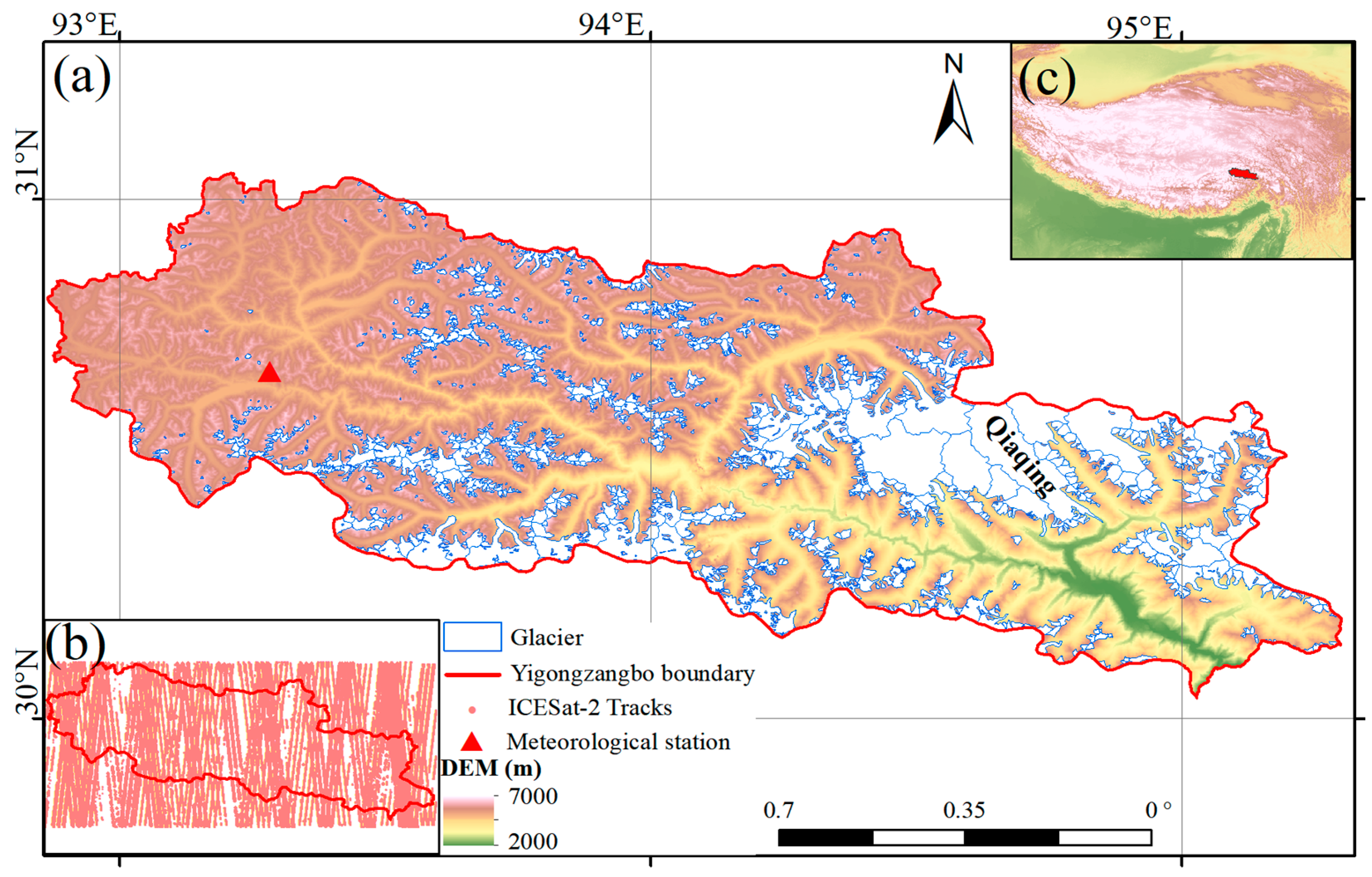
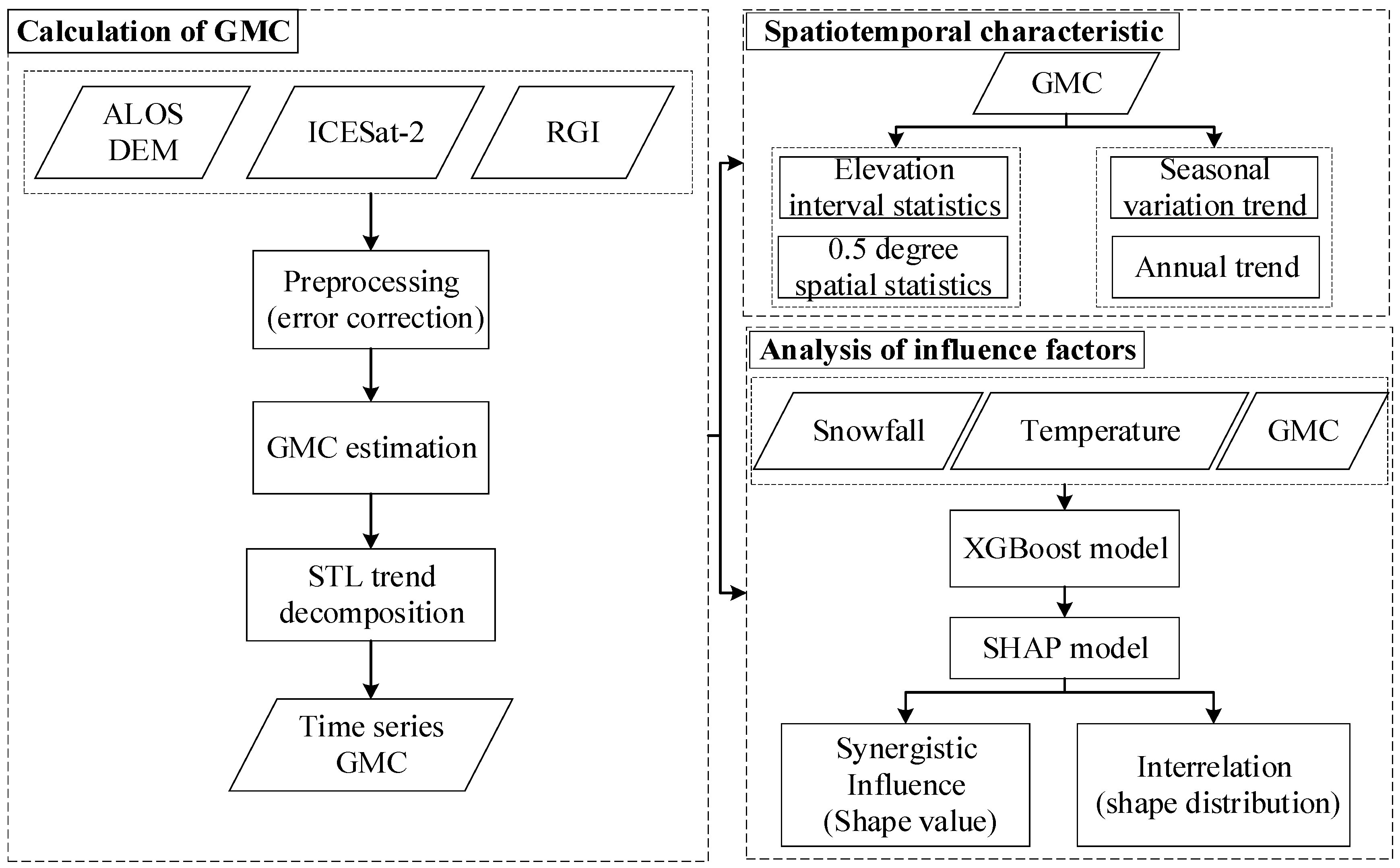
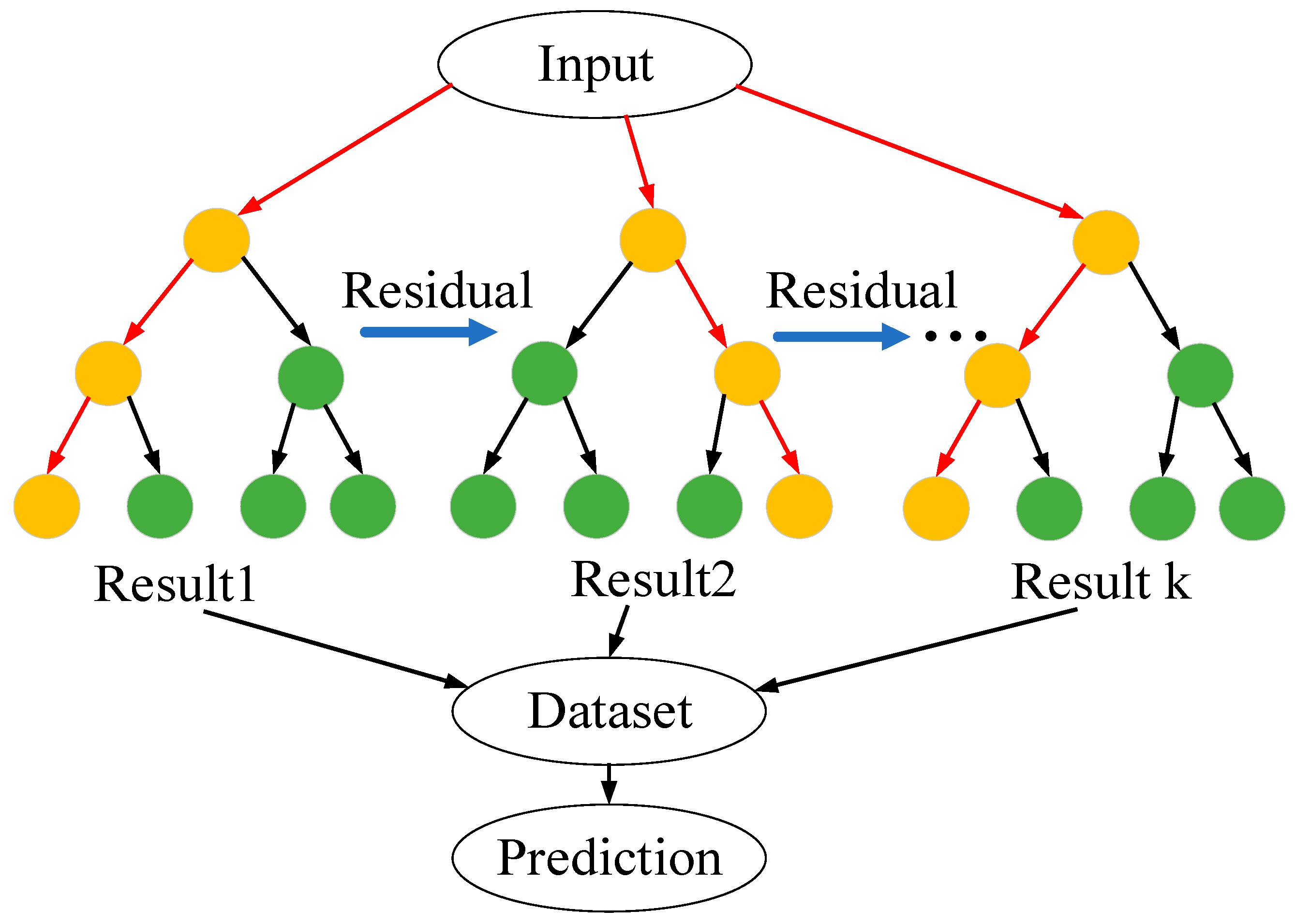
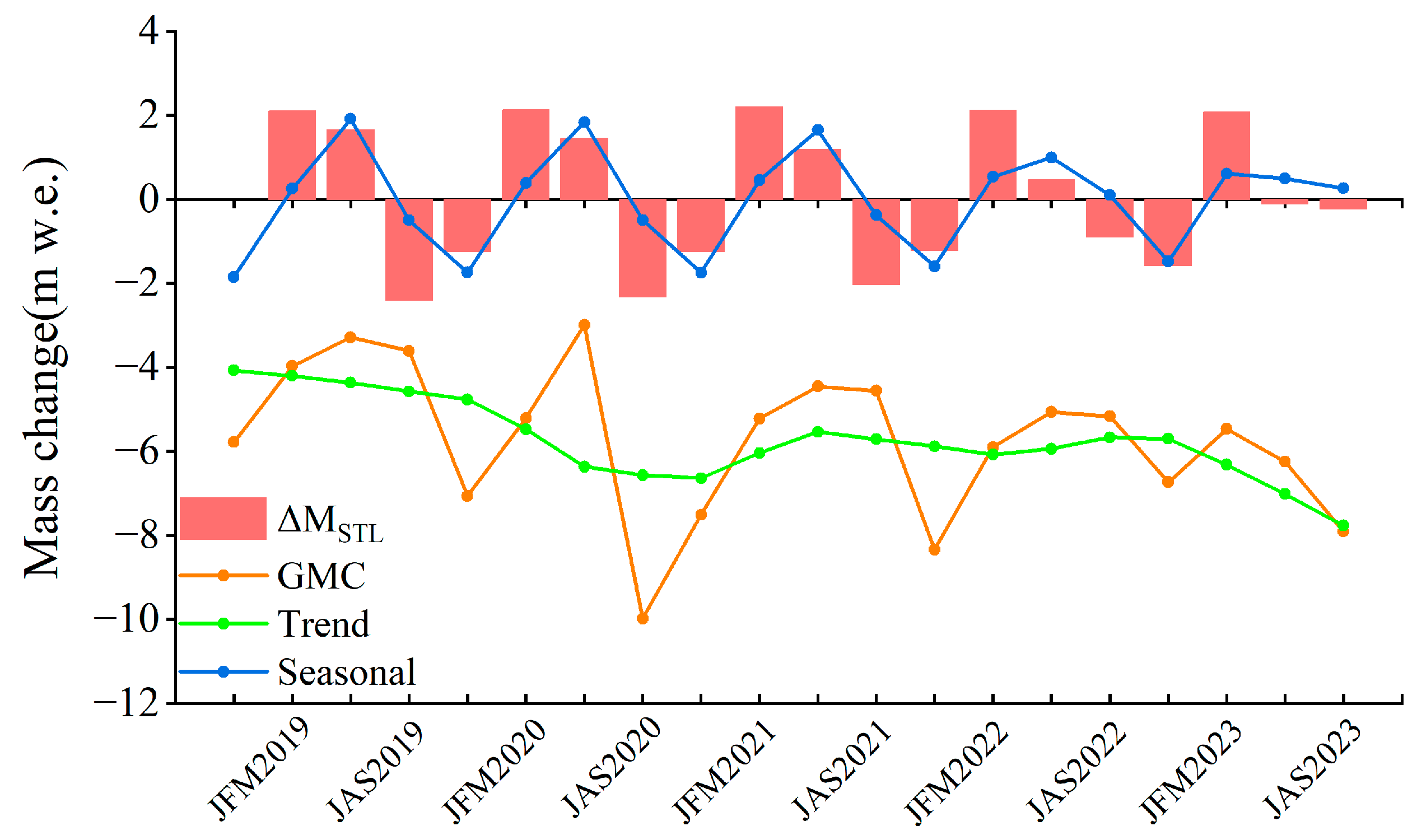
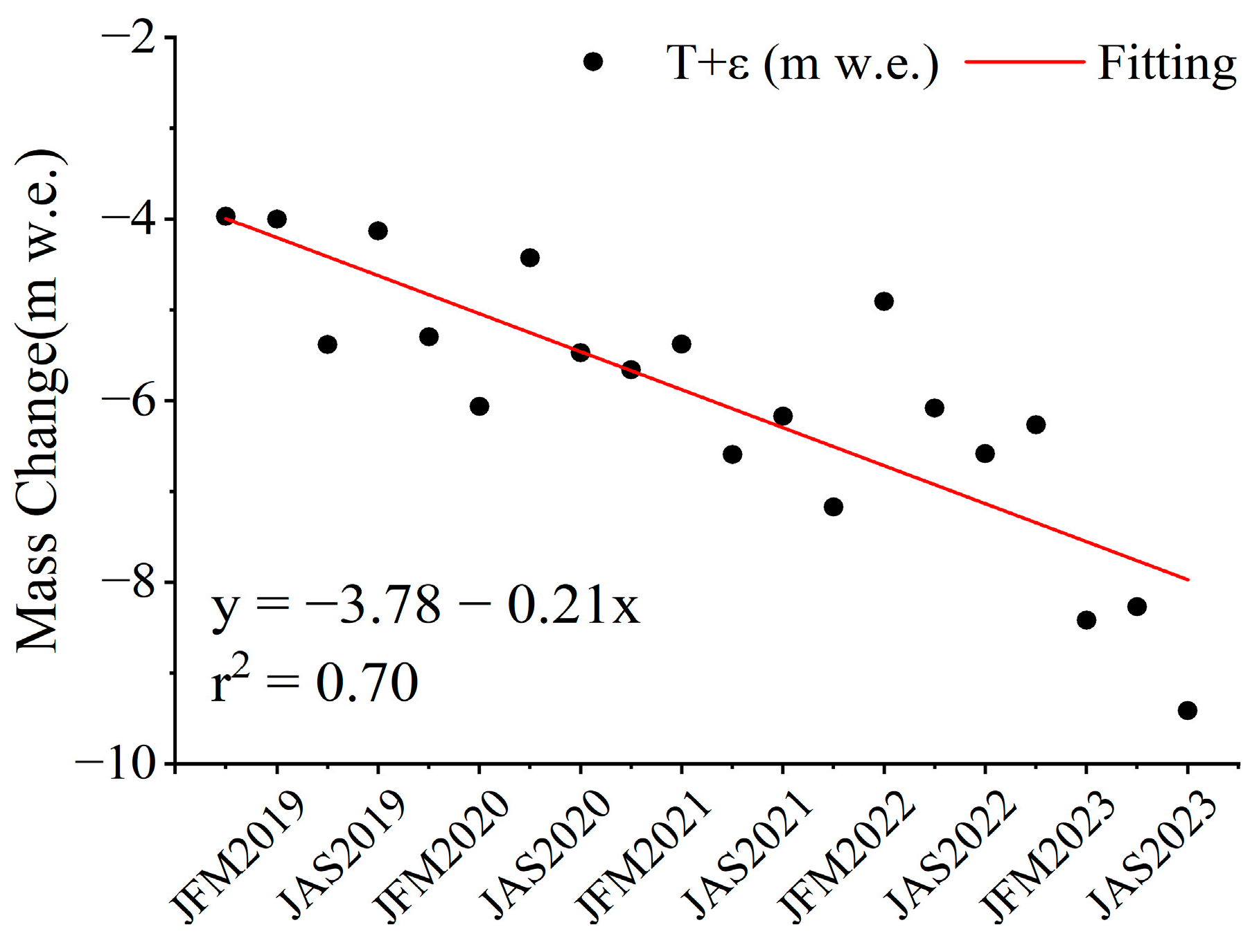

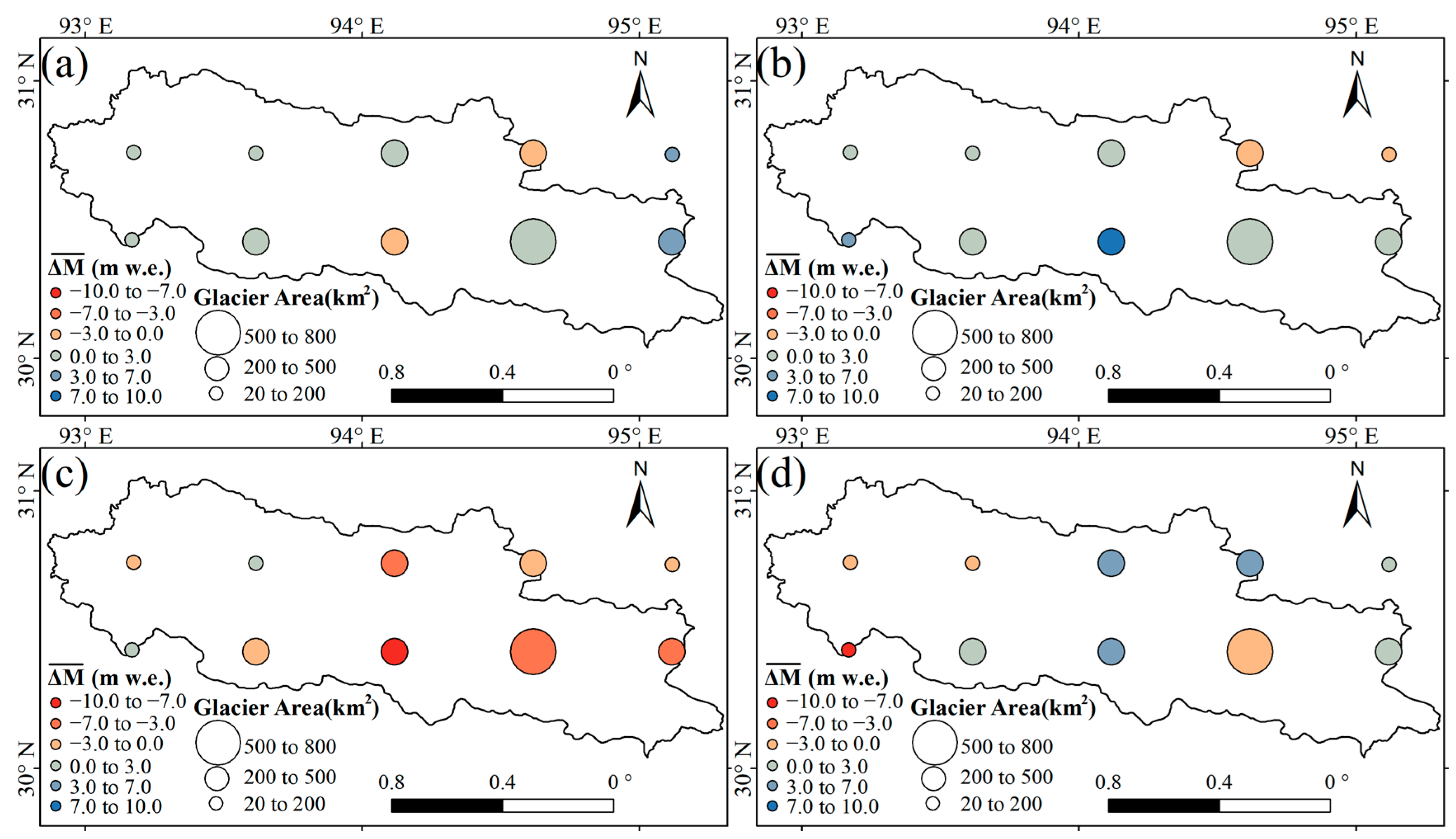
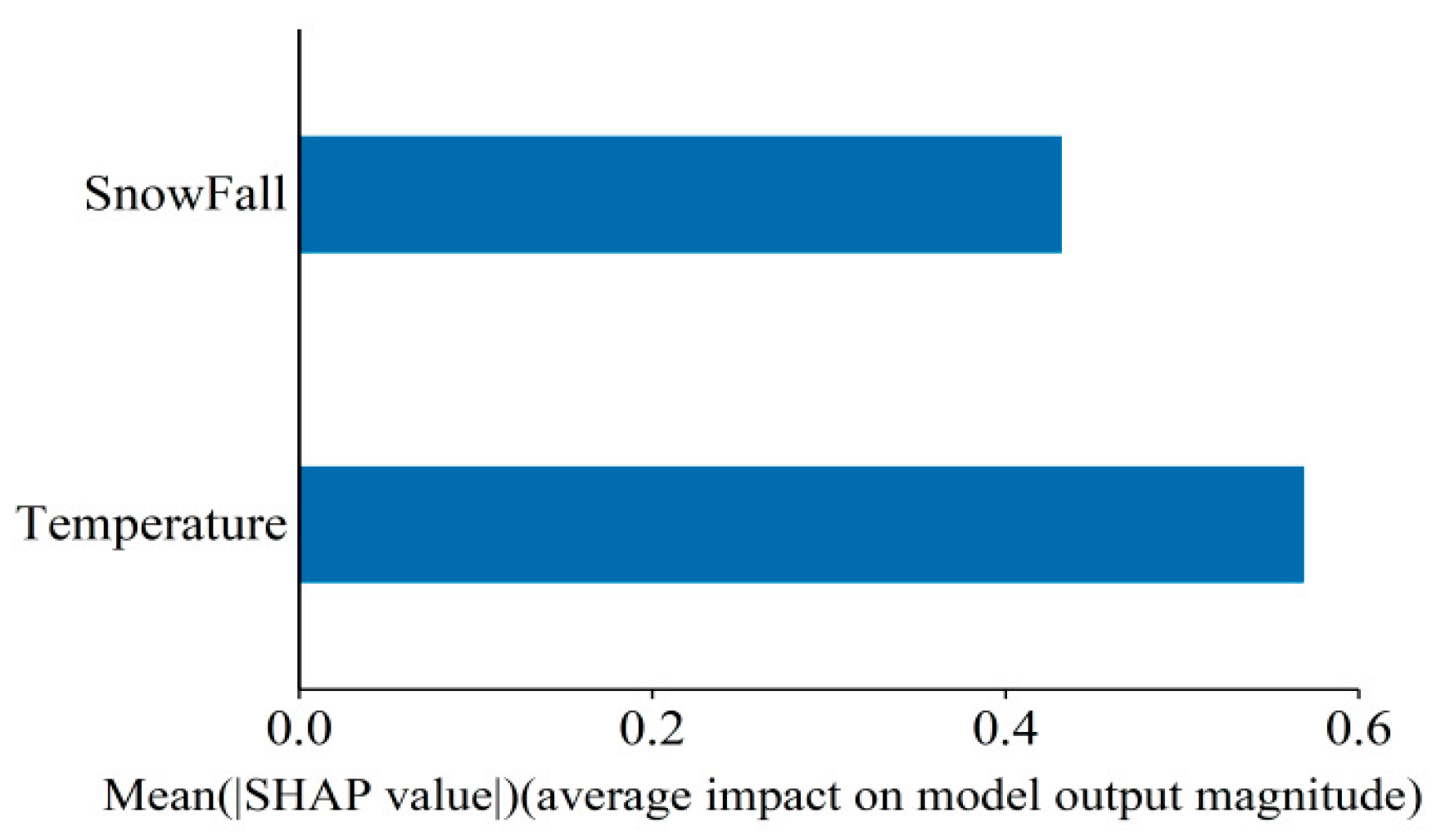
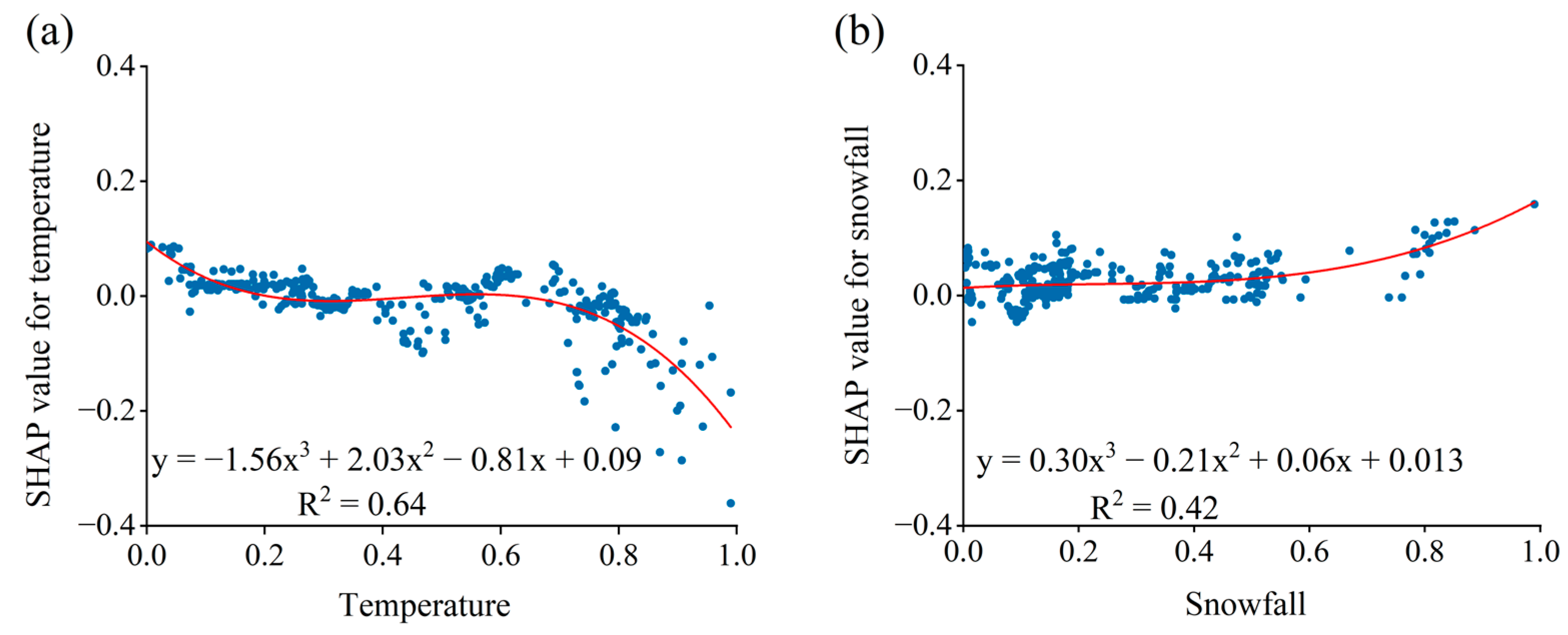

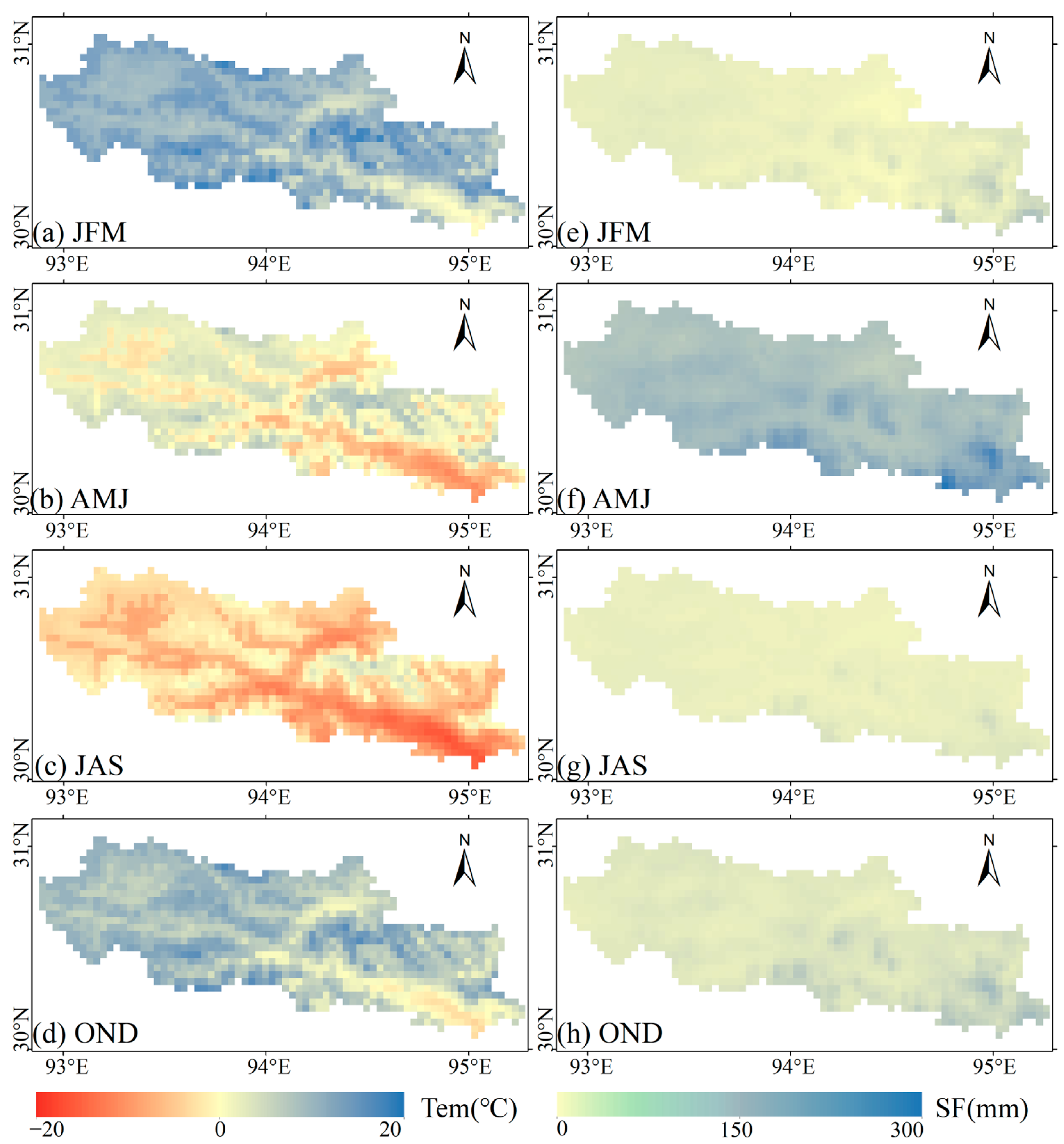
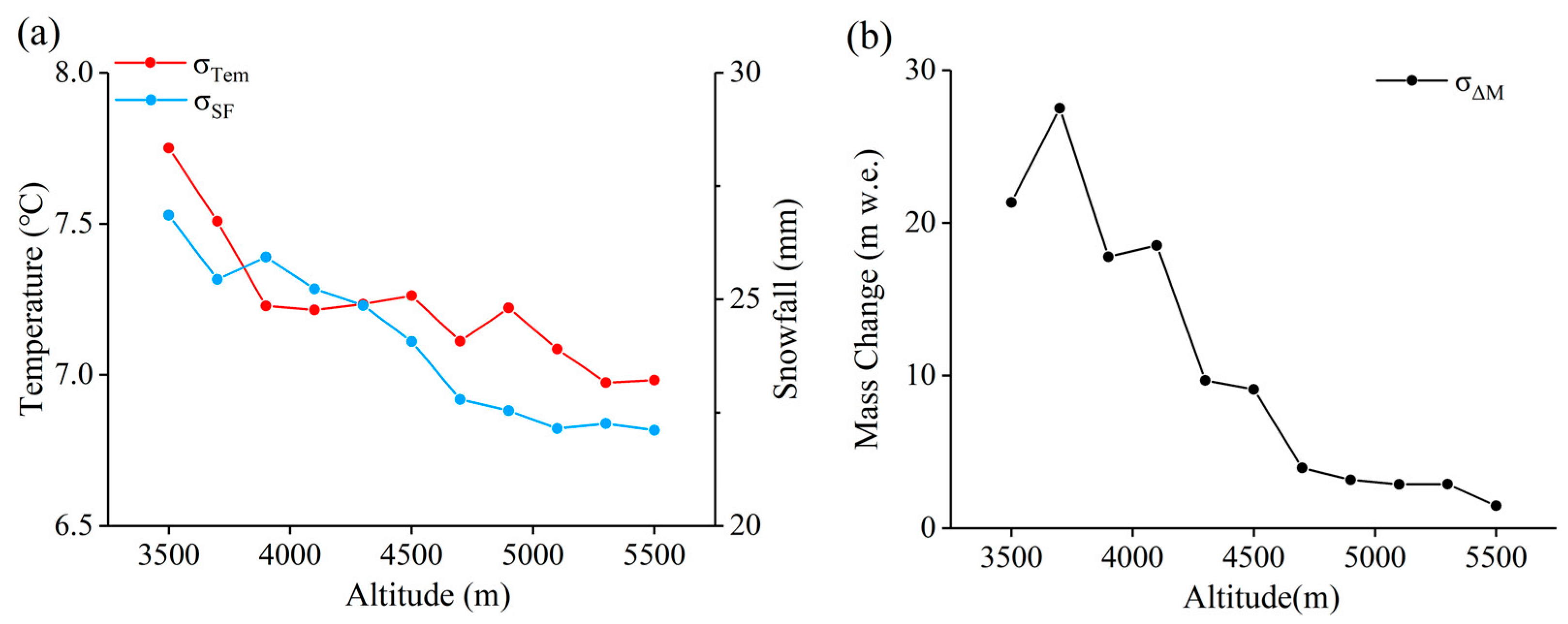
Disclaimer/Publisher’s Note: The statements, opinions and data contained in all publications are solely those of the individual author(s) and contributor(s) and not of MDPI and/or the editor(s). MDPI and/or the editor(s) disclaim responsibility for any injury to people or property resulting from any ideas, methods, instructions or products referred to in the content. |
© 2024 by the authors. Licensee MDPI, Basel, Switzerland. This article is an open access article distributed under the terms and conditions of the Creative Commons Attribution (CC BY) license (https://creativecommons.org/licenses/by/4.0/).
Share and Cite
Nie, W.; Du, Q.; Zhang, X.; Wang, K.; Liu, Y.; Wang, Y.; Gou, P.; Luo, Q.; Zhou, T. Research on Glacier Changes and Their Influencing Factors in the Yigong Zangbo River Basin of the Tibetan Plateau, China, Based on ICESat-2 Data. Water 2024, 16, 2617. https://doi.org/10.3390/w16182617
Nie W, Du Q, Zhang X, Wang K, Liu Y, Wang Y, Gou P, Luo Q, Zhou T. Research on Glacier Changes and Their Influencing Factors in the Yigong Zangbo River Basin of the Tibetan Plateau, China, Based on ICESat-2 Data. Water. 2024; 16(18):2617. https://doi.org/10.3390/w16182617
Chicago/Turabian StyleNie, Wei, Qiqi Du, Xuepeng Zhang, Kunxin Wang, Yang Liu, Yongjie Wang, Peng Gou, Qi Luo, and Tianyu Zhou. 2024. "Research on Glacier Changes and Their Influencing Factors in the Yigong Zangbo River Basin of the Tibetan Plateau, China, Based on ICESat-2 Data" Water 16, no. 18: 2617. https://doi.org/10.3390/w16182617





